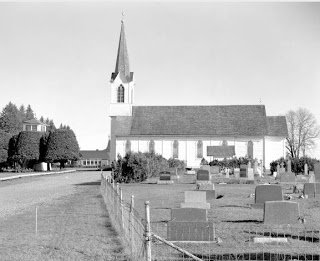 |
St. Boniface Church, 1959
|
James Denny, one of the early settlers, thought this community ought to be called “Sublimity” because of the fine vista and sublime scenery in the hills around the town. The same is true today: on our visits we have been impressed by the peaceful quality of the town and the beauty of the farming community.
The Sublimity area before 1840 was a vast forest, interspersed by Indian trails and sparkling mountain streams. A large Indian burn in the early 1800’s cleared the land where the present town now exists. Sublimity had its beginning as an outgrowth of an Indian village or trading post before 1846.
As early as 1852 the area served as a convenient gathering place for wagon train pioneers and had a primitive store as a hub for the surrounding area. In September 1852 an Oregon Territorial post office was established and the town got its official name. The post office has been in continuous service since 1852 making it one of Oregon’s oldest post offices.
In 1856, Sublimity School District No. 7 was organized. The first building was a log cabin with a dirt floor. The following year, Sublimity College, a semi-public institution was established and operated by the Church of United Brethren. By modern standards it was more like a grade school but gave early Sublimity the distinction of being a college town. The first teacher and president of the college was Milton Wright, father of Wilbur and Orville Wright. Early Sublimity was a larger town than it is today. In 1857 it had a Chinese Laundry, five stores, a gun maker’s shop, a public school, a college, Methodist Church, United Brethren Church, a hotel, post office, public well, and a made-to-order furniture shop.
When the Civil War broke out Sublimity was a town of 1,500 but people returned to their native states to fight and the town became deserted. Population declined and depression set in. The 1860’s brought resettlement by German Immigrant farmers. By 1874 nearly all the abandoned farms around Sublimity were possessed by new people and the town grew rapidly. In 1878 the town was divided into 20 city blocks. Buildings included a hotel and rooming house, a store, saloon, blacksmith, and LaCroix’s Store.
Railway immigrants from the midwest founded St. Boniface church in 1879, Fr. Peter Juvenal Stampfl pastor. Built in the Carpenter Gothic style of architecture, it is a massive six-bay wooden structure with lancet stained glass windows and a steep sloping roof. The cross-adorned steeple above its front entrance reaches to a height of 110 feet above the ground. Its historic cemetery adjoins the church building on one side. It stands on the former Sublimity College site.
Sublimity was incorporated and granted its own charter in 1903. John Kintz was elected the town’s first mayor in that year. In 1912 the city saw the first fire fighting equipment. Electric lights were brought to town in 1914.
In Capitol Journal news of the 1920s, we see these items:
1923: Paving between Stayton and Sublimity, to start early in July, would be over a log road 10 feet high laid down by Downing in the early 1870s. Between these points in 1871, F. T. Wrightman recalled, there was a great morass. Through this swamp Downing laid poles 10 feet high and covered his road laid on piles with earth. By 1923 the pole roadbed had sunk out of sight. It was the foundation of that part of the road between Stayton and Sublimity that was soon to be paved.
1926: A sedan owned by John Boedigheimer was still standing in the street at Sublimity. John left his car briefly and when he returned he discovered a swarm of bees had taken over. The swarm established itself under the back seat where they were impossible to dislodge.
1927: A debate between Sublimity and Stayton men was held on the question, “Resolved: that the dishrag is more important than the broom.” Judges decided 2 to 1 in favor of the dish rag.
(See Ben Maxwell’s Salem, Oregon, edited by Scott McArthur, 2006)
 |
| The city’s portrait |
Today the city of Sublimity is a rural, residential community of less than one square mile, located on the western low foothills of the Oregon Cascades about 15 miles southeast of Salem on Highway 22. It is situated north of the Santiam Highway (directly to the north of the city of Stayton) amid gently rolling hills and land well suited for agriculture.
Grass seed farming is very popular and the farming of row crops such as Green Beans, Corn, Broccoli, Carrots, Strawberries and other types of berries. Farm equipment can be seen on the roads during the summer and fall months. Marion Estates (Senior living) is the largest employer in Sublimity and there are 46 licensed businesses.
In the 1990s and early 2000s, the population doubled, reaching the present number of 2,681. The city has a mayor and four city council members. There is a Finance Director who is City Recorder, a Public Works Department of two members, a City Attorney and Auditor. There is a Sewer Committee and Planning Commission. Police services are under the Marion County sheriff. The city is served by the Sublimity Rural Fire Protection District, a volunteer department with two fire stations–a new station built in 1989 on Parker Street and another station outside town on Drift Creek Road. Sublimity contracts with the City of Stayton for sewer treatment and disposal.
Currently the city has two beautiful parks. One is adjacent to city hall and has a tennis court, baseball diamond, picnic shelter, and playground equipment. The other park on East Main Street has a picnic shelter, jogging trail, barbecues, and playground equipment. This park is in a beautiful wooded setting and is about six acres in size.
Visitors are treated to a variety of attractions. In July, the Santiam Canyon Stampede puts on a rodeo event. The first weekend after Labor Day in September is the occasion of the Sublimity Harvest Festival featuring Monster Trucks and Truck, Tractor ATV and Horse Pulls. Area school groups and other local organizations are recipients of grant monies from this event.
Sublimity remembers its residents’ military service with a War Memorial across from church.
The St. Boniface Community Archives and Museum, founded in 2006, is located in the old convent building across from the church, the second oldest church building in continuous use in Oregon. The facility is open, without fee, 9:00 to noon on Tuesdays (503 769 5381). The Archives and Museum website lists an impressive number of records, publications, photographs, family histories and artifacts outlining the city’s history and traditions. The building itself, especially the second floor where the sisters once lived, transmits the spirit of the nuns’ lives as teachers and spiritual leaders. Rarely does one find such a dedicated volunteer effort to preserve a community’s history as one finds in Sublimity. Of especial interest is An Illustrated History of Sublimity from the 1850s on by Henry Strobel, 2003.
Nearby are the popular Silver Falls State Park and the Silver Creek Youthcamp Historic District & Concession Building Area Historic District.
We are indebted to Carol Ditter for her hospitality and generous help in compiling this Sublimity information. Tom and I have enjoyed lunches at the Wooden Nickel, a comfortable pub, and at Canyon’s Edge. Other choices include Denim Country, Rob’s Panezanellie’s and Sloper Restaurant in Marian Estates. When you visit Sublimity, check out the Kiosk by City Hall at 245 NW Johnson Street for upcoming event information as well as city maps and the CARTS route schedules. Local newsletters and shopping guides are also sometimes available.
Each Tuesday, after a city was featured in that Sunday’s Statesman Journal, KMUZ broadcasted “Marion County 20”. To learn more about Sublimity, listen to the podcast listed on the KMUZ website archives.



4 Comments